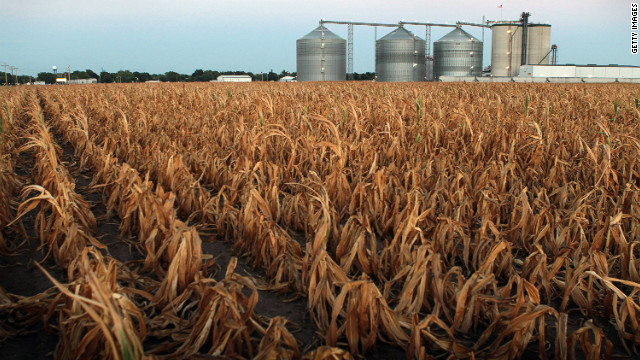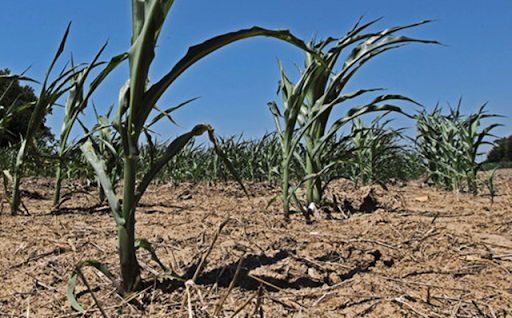

| Visitors Now: | |
| Total Visits: | |
| Total Stories: |

| Story Views | |
| Now: | |
| Last Hour: | |
| Last 24 Hours: | |
| Total: | |
Scant Rain to give Scorched US Southwest Crops Little Relief

According to the latest edition of the U.S. Drought Monitor, released Thursday morning, between July 17 and July 24, the portion of the country affected by “extreme” to “exceptional” drought jumped from 14 percent to about 21 percent. The portion of the country affected by exceptional drought, which is the most significant drought category, rose from 1 percent last week to 2.4 percent this week. [29] For the U.S. as a whole, including Puerto Rico, 53.44 percent of the land is affected by drought. [25]
HERE More than 80 percent of pasture and rangeland from Kansas to Indiana was in poor or very poor condition, Heim wrote. All categories of drought expanded across the Midwest last week, he said. [25] In Kansas, Arkansas, Missouri, Illinois, and Indiana, more than 80 percent of the pasture and rangeland was rated in poor or very poor condition, the drought summary said. [29]
Milk, eggs, poultry, pork and cooking oil are also all expected to show a significant price increase as well due to the drought conditions. [7] Call said Palmer Drought Indices are one way meteorologists assess rainfall and drought conditions. He said that this measure compares rainfall by rank, and explained that only about 10% of years were drier than this year in all but a dozen states, roughly. Indiana’s rank is 3%, meaning it has only experienced drought conditions worse than this year about four times. 
HERE [48] The United States is suffering its worst drought in 50 years. That’s bad news for Americans. [26] As the Midwest is in the throes of the worst drought to hit the United States since the 1950s, the CEO of Magnolia is bracing for the dry weather’s ramifications from the company’s headquarters in Manhattan. “This drought is going to affect us in many ways,” Magnolia CEO Steve Abrams says. [44] In the southern Midwest, including Missouri and most of Illinois, Indiana and Ohio, more hot, dry weather was likely.
“Most of these areas need an excess of 10 inches of rain to break the drought,” said Jim Keeney, a National Weather Service meteorologist, referring to Kansas through Ohio. “This front is not expected to bring much more than a 1/2 to 1 inch in any particular area. It’s not a drought buster by any means.” [2] As fall temperatures arrive, Call expects the precipitation to go more quickly into the ground and accumulate more easily. Though he said predictability is very limited with droughts, Call estimates that if most states get an inch to two inches of rain a week for the next couple of months, things may start to look up by September. He reminded, expectations for a changing weather pattern aren’t high–a tropical system or sustained rainfall would be needed to change the drought trend. [48] Call said neither is very likely, and estimated that most states need nine to 12 inches of rain to fully erase the effects of the drought. Though the drought may continue into fall and winter, drought isn’t as noticeable during those seasons. [48] We’ve been getting a lot of rain the past week or two, but much of our state is still under a drought. [18] Minnesota has been far luckier. While this has been a hot summer, and parts of the state need rain, most of Minnesota isn’t in a drought. The two big exceptions are southwest Minnesota and the Red River Valley, both prime farming regions in a severe drought. [40]
HERE Europe’s deepening economic crisis is cutting into corporate earnings, with the continent’s woes threatening to exert a. The Dow Jones Industrial Average capped its biggest advance in almost a month Thursday after European Central Bank Presi. The most extensive U.S. drought in five decades intensified this week across the Midwest and Plains states that produce. [27] In the Heartland, one swath of the Midwest has escaped it, according to the latest U.S. Drought Monitor map — and that’s right here, in eastern Minnesota and northern Wisconsin. [40] The National Drought Summary, last released July 18 by the U.S. Drought Monitor, showed that two- thirds of the nation is experiencing moderate to exceptional drought. [47] The U.S. Drought Monitor has collected stories of boating companies struggling from falling water tables, golf courses suffering from irrigation restrictions, and waterparks forced to shut down rides. [44]
Moderate to severe drought has gripped at least two-thirds of the contiguous United States, according to the USDA’s Drought Monitor. [8] The Drought Monitor map is compiled weekly by the National Oceanic and Atmospheric Administration and the USDA. See more at droughtmonitor.unl.edu. The Associated Press contributed to this report. [40]
The Drought Monitor found 98 percent of the High Plains was abnormally dry, most of it in severe drought (although patches of North Dakota have escaped). [40] 
HERE Almost 30 percent of the nine-state Midwest was suffering extreme drought as of July 24, nearly triple that of a week ago. [5] In Nebraska, for example, the area affected by extreme-to-exceptional drought increased from about 5 percent on July 17 to 64 percent on July 24, a 13-fold increase. [29] In Illinois the area affected by extreme-to-exceptional drought jumped from about 8 percent to about 71 percent. [29] More than 60 percent of America’s farms are located in areas experiencing drought. [19]
The rain has been too little, too late to help farmers, and little rain fell in the most hard-hit drought areas. [29] Even areas that have picked up rain are still suffering because of the heat.” The drought mainly intensified in the region that was under the influence of this High Pressure area, since the sinking air near the High prevented showers and thunderstorms from forming. [29]
article continued HERE


